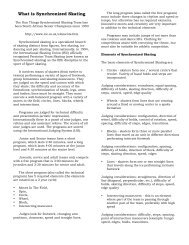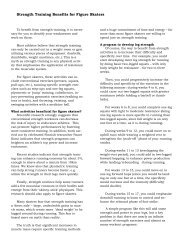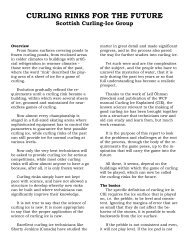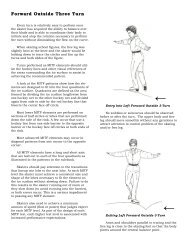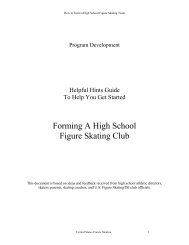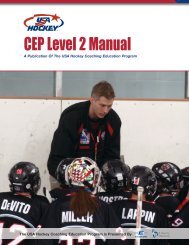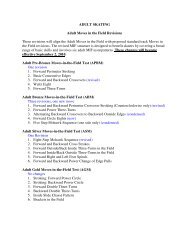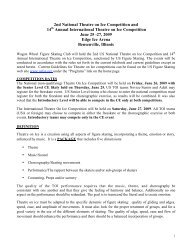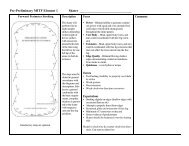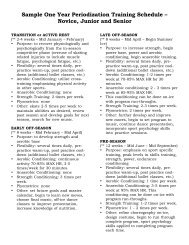CEP Level 3 Manual - Rushmore Hockey Association
CEP Level 3 Manual - Rushmore Hockey Association
CEP Level 3 Manual - Rushmore Hockey Association
You also want an ePaper? Increase the reach of your titles
YUMPU automatically turns print PDFs into web optimized ePapers that Google loves.
T A B L E O F C O N T E N T Sposts, boards, pucks, sticks and with the ice itself.It’s all part of the game. But injuries - especiallypotentially serious head injuries - are not part ofthe game.You can raise your player’s awareness of spinalinjuries and concussions by learning more abouthow injuries happen, by passing this informationalong to your players and by practicing specificprevention and playing techniques detailed in thischapter.Let’s start by learning more about how theseinjuries happen.How Spinal Injuries Happen In <strong>Hockey</strong>The upper cervical spinal column has a naturalcurve, which lends flexibility to the head and neckwhen the neck is held in a normal, “Heads Up”position. (See illustration A)lIllustration A. The natural “Heads Up”position, which gives your neck the maximumflexibility to take a hit.However, when the head is flexed (chin towardthe chest), this normal curve is removed, and thecervical spine becomes straight, as illustration Bdemonstrates.lIllustration B. When the neck is flexed (headdown), an impact can result in serious spinalinjury.In this “head down position,” if a player hits theboards or a goal post head on, the head stopssuddenly, but the body’s movement continues,compressing the spine. This force can produce ashock greater than the neck’s discs and muscles cancushion, resulting in a fracture or break of one ormore of the vertebrae. And if one breaks, it cancause compression of the spinal cord, resulting inparalysis below the level of the fracture.According to research done among a wide rangeof hockey players, almost all on-ice cervical spineinjuries have been due to the head being slightlyflexed (head down) while making head-on contactwith the boards or goal post.A player doesn’t have to be going at full speedfor this to happen — it can occur at walking speed.So that’s the basis for Rule One of “Heads Up <strong>Hockey</strong>”:Heads Up – Don’t Duck!How Concussions Happen In <strong>Hockey</strong>There are differences of opinion on thedefinition of a concussion, and on how to judge itsseverity.But one working definition is: “a clinicalsyndrome characterized by immediate and transientpost-traumatic impairment of neural functions, suchas the alteration of consciousness, disturbance ofvision, equilibrium, etc., due to brain steminvolvement.”Simply put, it’s an injury that arises from a blowto the head, usually when the head is moving.Symptoms of a concussion range from milddizziness to “seeing stars” to severe headaches andnausea to unconsciousness.In hockey, concussions are not the mostcommon form of injury, but they require yourattention for two important reasons.1. Concussions, especially mild ones, may behard to recognize. Players may show onlymomentary confusion from being “dinged” or“having their bell rung”.2. A concussion, even a mild one, maysignificantly increase the chances of getting asecond concussion, and may endanger theplayer’s awareness and safety on the ice.No head impact injury can truly be regarded asminor. Each incident requires your promptevaluation and attention.What Can You Do?The risk of head injuries at all levels of hockeycan be reduced through your participation in“Heads Up <strong>Hockey</strong>”.1. Play Heads Up <strong>Hockey</strong>• Know the basics of injury preventionand pass them along to your players.• Practice the team on-ice safetyexercises in this chapter.• Promote fair play and cleanchecking on your team, and insist onit from your opponents.2. Check your players’ equipment before,during, and after each practice session orgame, and teach them to inspect it as well.3. Keep your team in good shape through theflexibility and strengthening exercises in thischapter.4. Know what to look for and how to respondwhen a player gets hurt by using theinformation in this chapter.PLAYING HEADS UP HOCKEYIncorporating “Heads Up <strong>Hockey</strong>” Into TeamPracticesIn this section, you’ll find specific ways toimprove the safety and quality of your team’s play.Here are some ways to incorporate this material intoyour practice routine.• Show the “Heads Up <strong>Hockey</strong>” Challengevideotape at the beginning of each session.Invite parents and team managers to see it.• Plan on 15 minutes of “Heads Up <strong>Hockey</strong>”atevery other practice session.• At each of these “Heads Up <strong>Hockey</strong>”sessions:• 5 minute (max) pre-session talkwith Q & A• 10 minute on-ice drill• Five “Heads Up <strong>Hockey</strong>” sessions totalHeads Up — Tell Them What It MeansWhen we hear the phrase “Heads Up”, we hear“be alert” and “be careful”. Good advice for hockeyplayers! But in “Heads Up <strong>Hockey</strong>”, it has a literalmeaning too.At your first practice session, start by asking yourplayers what they think “Heads Up” means, andhelp them translate it into hockey terms. You mightget answers like:• know where the puck is• know where your teammates are• know where your opponents are• know where you’re skating to• be ready to receive a pass or take a shot• know where your “man” is• look for open iceNext, you can refer to the idea of “Heads Up” asplaying safe hockey. Ask players what else thephrase means to them.58 | USA <strong>Hockey</strong> Coaching Education Program <strong>Level</strong> 3 <strong>Manual</strong>Risk Management | 59



